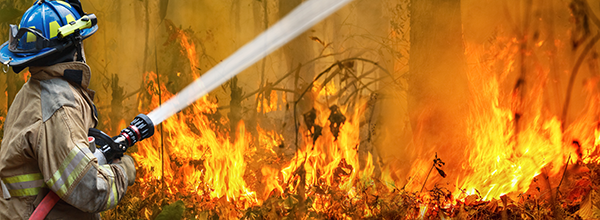
Jan. 15, 2020 - A UC Irvine-led team has received $3.6 million over three years for a project that uses science and engineering to help California fight wildfires. The funding comes from the University of California Laboratory Fees Research Program competition, a contest designed to promote the development of multicampus projects and collaborations that advance the missions of the national laboratories and University of California.
As wildfires in California grow more frequent and severe, experts point to a number of reasons for the concerning trend, including a policy of active fire suppression that has led to a massive fuel accumulation over the last century. Coupled with tree mortality, drought and climate change has resulted in a year-round fire season and an increase in life-threatening megafires.
According to principal investigator Tirtha Banerjee, UCI assistant professor of civil and environmental engineering, one of the most effective tools for reducing wildland fuels (vegetation) and wildfire severity is intentionally setting controlled fires, or prescribed burns.
“In other parts of the United States, and especially in the Southeast, prescribed fire is a primary tool for managing fuels and fire risk, but in California the use and benefits of this optimal approach are far from meeting their full potential,” said Banerjee, who joined the UCI faculty in July 2019. “Our goal is to apply modeling, data science and risk-management strategies to the problem and help lower the current barriers to widespread application of prescribed fires.”
The research will integrate physics, chemistry, engineering, computer science and ecology to conduct and disseminate information supporting an increase in the pace and scale of prescribed fires in the region.
“Prescribed burns are a preemptive way to create community resilience by preventing wildfire events from escalating into large catastrophes that have human, environmental and economic impact," said Nalini Venkatasubramanian, UCI professor of computer science and a co-PI on the grant along with computer science Professor Sharad Mehrotra.

The team also includes researchers from UC Riverside, UC Berkeley, UC Agriculture and Natural Resources and the Los Alamos National Laboratory. LANL will contribute laboratory time, valued at more than $980,000.
Controlled burns can have a downside. If conducted in unfavorable conditions, they can lead to bad air quality in neighboring communities, loss of species diversity and even, in worst-case scenarios, can turn into wildfires. This is further complicated by the state’s complex and ever-growing wildland urban interface and mountainous landscapes. Better information about ignition strategies, smoke transport, and sensitivity to dynamic environmental conditions and safety envelopes could help increase the use of prescribed fire as a prevention and management strategy. Emerging IoT technologies provide new capabilities for fine-grained monitoring and control of the prescribed burn.
The UC-LANL team has expertise in fire and smoke modeling, and information technology-enabled decision support. Researchers will develop new models and technologies, apply them in the field during planned burns, and transfer knowledge and skills through UC extension programs and student training. The proposed research will seed the creation of an innovation hub that will serve as a center for knowledge exchange and technology transfer, training a new generation of scientists, engineers and practitioners to address one of the region’s most pressing problems.
"Creating accurate situational awareness from the field is essential to orchestrating and managing the safe execution of prescribed fires,” explained Venkatasubramanian. “Our team will design information-centric platforms that can integrate live sensing data, simulation/modeling technologies and intelligent analytics. Fire agencies can use these tools to intelligently plan and tune fire management strategies for our communities.”
“Wider use of prescribed fires will help make the megafires more manageable and less catastrophic by introducing the so-called ‘good fire’ to the landscape as a management tool,” said Banerjee. “This project will allow us to build and advance the science and engineering basis to develop this tool further and facilitate its usage.”
The team was one of six proposals in total to receive $21 million in UC funding in three targeted areas: accelerator research, quantum information science and wildfire-related research.
– Lori Brandt
